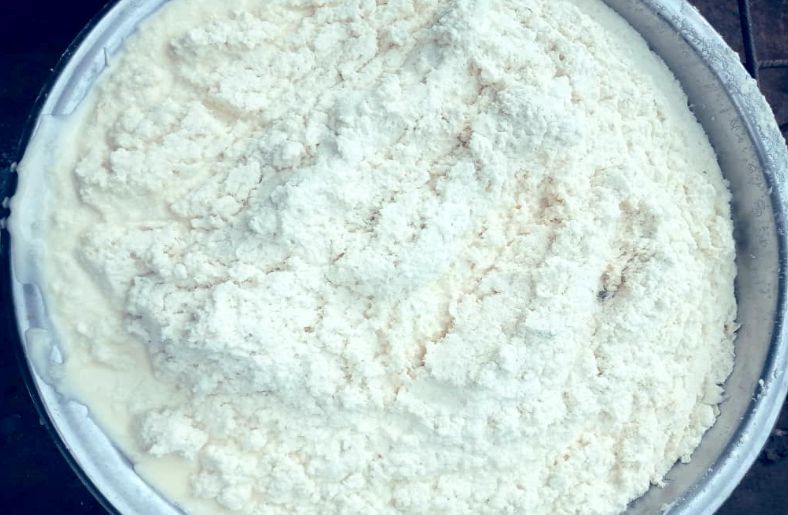Grated cassava adds texture and flavor to traditional and modern dishes. Get step-by-step tips on how it’s made, how to use it, and simple recipes to try.
The memories I have of grated cassava as a kid are harvesting cassava roots, peeling, washing, and taking them to a mechanical grater, and afterwards, we use it for garri in Nigeria.
I was jolted out of my reverie when I learned about using this form of cassava for many delicious dishes, and ever since, I have thought my people to be creative with this root crop.
Grated cassava fits right into your kitchen plans when you want something filling, textured, and easy to work with.
You can make it fresh or buy it frozen, depending on your time and tools.
It blends well into savory and sweet recipes and holds its shape better than cassava flour or starch.
You’ll find it in dishes like cassava pie, flatbreads, and traditional cakes across cultures.
If you’re thinking of freezing it or using the frozen packs, there are ways to do it right without losing flavor.
In this guide, you’ll get practical steps for making grated cassava, storing it, using it in real recipes, and knowing exactly where to buy the frozen kind.
This isn’t complicated cooking; it’s about turning a root into something satisfying and worth repeating.
Table of Contents
- What is Grated Cassava?
- Why Grate Cassava Instead of Using Other Forms?
- How to Make Grated Cassava
- Grated Cassava Uses
- Grated Cassava Recipes
- Frozen Grated Cassava
- Where to Buy Frozen Grated Cassava
- How Can I Freeze Grated Cassava?
- How to Use Frozen Grated Cassava in Cooking
- Storage Tips for Grated Cassava
- Frequently Asked Questions
- Conclusion
What is Grated Cassava?
Grated cassava is the raw, shredded form of the root of the cassava plant, prepared by peeling and grating the tuber into a fine or coarse form. It holds more moisture than processed forms like cassava flour or tapioca starch and has a slightly fibrous texture.
High in starch and carbohydrates, it serves as a filling base in many traditional dishes.
This form of cassava is commonly used in recipes across Africa, Southeast Asia, and the Caribbean, where it’s steamed, baked, or cooked into savory and sweet meals.
Its natural texture makes it ideal for recipes that require body, chew, or a slightly dense consistency.
Recommended: Cassava Pancake vs Cassava Flour Pancake
Why Grate Cassava Instead of Using Other Forms?
Grated cassava brings more to your dish than the processed alternatives.
When you want texture, moisture, and flavor in one bite, it’s the better choice every time.
Flavor: You Keep the Root’s Natural Taste
When you grate cassava, you hold on to the root’s real taste. Cassava flour and starch lose this in processing.
In savory meals like patties or casseroles, that earthy flavor adds depth.
You’ll notice it especially when the dish calls for fewer spices.
If you’re aiming for bold, honest flavor without needing extras, this form of cassava gives you a better result than the stripped-down versions.
Texture: It Adds Body and Bite
You feel the difference in your mouth. Grated cassava keeps a soft but slightly coarse texture, which flour and starch can’t match.
This gives your fritters, dumplings, or pies a more satisfying bite. Instead of a smooth or gummy feel, you get something you can chew into.
That’s why it’s so common in recipes that call for structure without needing breadcrumbs or flour-based fillers.
Moisture: It Keeps Your Dish Tender
Unlike flour or starch, this form of cassava holds moisture from the raw root. That makes your cakes softer and your pudding more delicate.
You don’t need to add extra fat or liquids to make up for dryness. The natural dampness blends into your batter or mixture and cooks through evenly.
This also helps it soak up seasonings better, giving you a deeper taste in every bite without overworking the ingredients.
Balance: Works in Sweet and Savory Recipes
You can swing both ways with grated cassava. Mix it with sugar and coconut milk for a soft dessert.
Or pair it with onions and chili for a spicy base. It adapts to whatever your kitchen needs.
You won’t need to swap ingredients when switching between meal types.
From African fufu to Caribbean pies to Filipino snacks, it fits right in and does the job well on both ends.
Related Posts
Modern Methods of Processing Cassava
Cassava Processing Equipment Guide
How to Peel Cassava with Mechanized Equipment
Traditional Methods of Processing Cassava
What Goes into Setting Up a Cassava Ethanol Processing Plant?
How to Make Grated Cassava
Grating cassava at home gives you more control over taste and freshness.
With the right tools and a few simple steps, you can prepare it safely for any recipe.
Wash and Prepare Your Cassava Roots
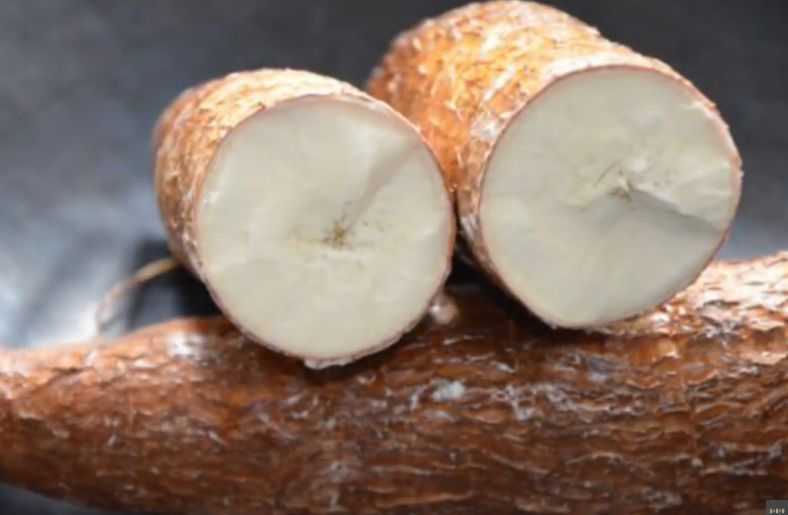
Start by rinsing the roots under running water to remove dirt and grit. Cassava grows underground, so you want to scrub it well.
If you’re working with more than one root, clean them all at once to save time.
Use a brush or the back of a knife to remove stubborn spots. A clean root makes peeling easier and helps protect your kitchen tools from damage later.
Peel and Cut into Smaller Sections
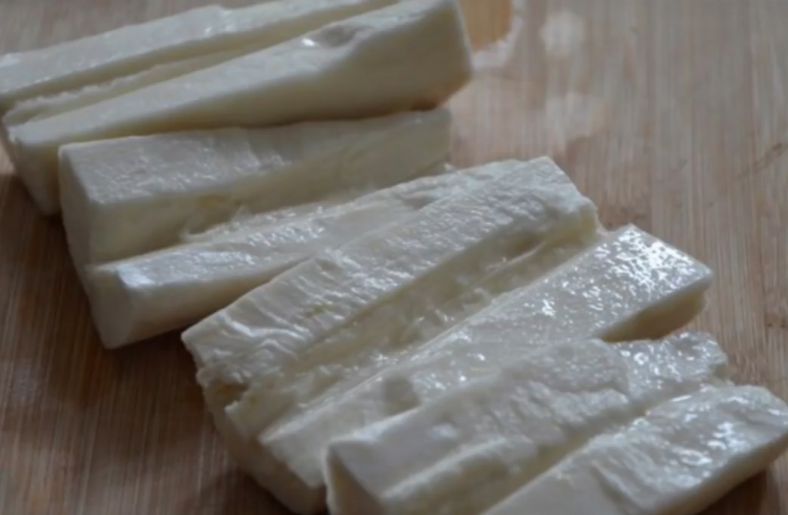
Use a sharp knife to remove the thick brown skin and the thin pink layer beneath it. You’ll reach the firm white flesh inside.
Don’t cut too deep; you want to keep as much of the usable part as possible.
Once peeled, cut the root into smaller chunks, about the length of your hand.
This helps when you start grating, especially if you’re using a hand tool or food processor.
Grate by Hand or Use a Food Processor
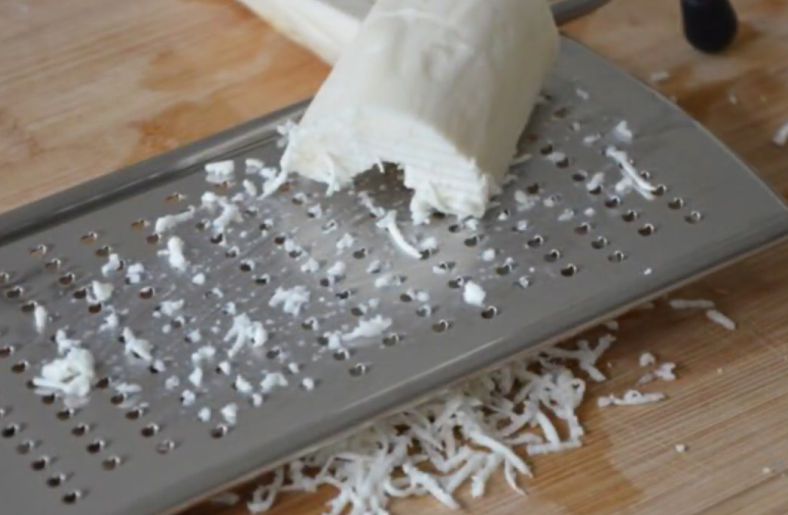
If you’re using a hand grater, place the cassava piece firmly against the grater and move it steadily.
The goal is to keep the texture even. For a food processor, cut the chunks into smaller cubes and process in short bursts until shredded.
After grating, it should be moist, not watery, and the shreds should be fine enough to mix easily into your dish without clumps.

Soak if You’re Using Bitter Cassava
Bitter cassava can be toxic if not prepared correctly. If you’re unsure of the variety, soak the grated cassava in water for at least four hours.
This helps reduce cyanogenic compounds that cause bitterness.
After soaking, drain the liquid and press out any extra moisture using a fine sieve or cheesecloth.
The goal is to keep the texture moist but not soggy, so it cooks evenly.
Keep It Clean and Safe to Eat
Always wash your hands before you start and clean your tools and work area.
Use a clean cutting board and make sure your grater or food processor is free from residue.
If you’re storing the grated cassava right away, seal it in a clean container or freezer-safe bag.
Food safety matters here, especially since raw cassava can spoil quickly if left out too long.
Related: How to Make Vegan Grated Cassava Cake
Grated Cassava Uses
Grated cassava fits into more recipes than you might expect.
From traditional dishes to modern meals, it gives you texture, structure, and flavor without needing anything fancy to make it work.
Cassava Cake: A Sweet Favorite with Coconut
You’ve probably seen cassava cake at family gatherings or holidays. It’s rich, dense, and usually made with grated cassava and coconut milk.
The moisture in the grated root gives the cake its soft texture, while the starch holds it together without flour.
If you like baked treats that are easy to slice and share, cassava cake is a solid choice.
You can also tweak it with spices, nuts, or cheese for something more filling.
Bibingka and Other Filipino Desserts
In the Philippines, you’ll find grated cassava in sweet snacks like bibingka.
These rice-based cakes sometimes mix in cassava to add body and flavor.
When baked, the grated root gives a chewy bite and balances well with butter, salted eggs, or cheese.
It’s a dessert that fills you up without being too sweet. If you enjoy experimenting with rice cakes, try swapping some of the rice for cassava next time.
Bammy: Jamaican Flatbread with a Twist
If you enjoy curries, stews, or grilled fish, bammy is a great side. It’s a Jamaican flatbread made with soaked and grated cassava.
You press the grated root into a round shape and fry or steam it until it’s crispy outside and soft inside.
It soaks up sauce without falling apart. Bammy is gluten-free, filling, and brings a mild taste that pairs well with bold flavors.
Chin Chin with a Cassava Boost
Chin chin is a crunchy West African snack made from dough and fried in small pieces.
When you add grated cassava to the mix, you get extra texture and longer-lasting crunch.
It holds up better than regular flour-based versions, especially when stored.
You can flavor it with nutmeg, milk, or sugar, depending on the taste you want.
Cassava makes it lighter while still keeping that satisfying snap in every bite.
Cassava Pancakes: Gluten-Free and Satisfying
You don’t need wheat to make pancakes. Grated cassava gives you a soft center and crisp edges when fried in a pan.
Mix it with eggs, onions, and spices for a savory version, or sweeten it with sugar and coconut for breakfast.
The natural starch helps bind everything, so you won’t miss the flour.
This is perfect if you’re avoiding gluten or just want something new for the morning.
Baking Without Wheat: Gluten-Free Recipes
If you’re baking without wheat, grated cassava helps keep your cakes and breads moist and dense.
It doesn’t act like flour, but that’s the benefit; it adds structure and texture where flour falls short.
Blend it with almond or rice flour for better results.
You’ll notice the difference in banana bread, muffins, or even pie crusts.
It’s a solid move when you want natural ingredients and a fresh take on gluten-free baking.
Meat Extender for Everyday Cooking
Trying to use less meat in your meals? Mix grated cassava into patties, meatballs, or stews to stretch your ingredients without losing substance.
It absorbs flavor well and adds bulk that makes meals feel full.
It also lightens the dish, cutting down the heaviness you sometimes get with all-meat recipes.
You’ll save money, eat better, and still enjoy the same kind of texture and taste you’re used to.
Regional Traditions That Keep It Alive
In Nigeria, grated cassava shows up in garri, fufu, flatbreads, and snacks. In the Philippines, it’s more common in sweet baked goods.
In the Caribbean, it works as a base for both fried and steamed dishes. Each place has its way of using it, and none of them waste it.
If you’re curious about traditional foodways or looking for meal inspiration, grated cassava opens the door to regional dishes you may not have tried yet.
Grated Cassava Recipes
Grated cassava works well in a range of recipes, from savory to sweet.
One popular option is cassava pie, a baked dish that brings out the root’s rich texture and flavor.
While the full recipe includes cheese, eggs, coconut milk, and seasonings, you’ll find all the details in our dedicated cassava pie post.
There, you’ll get step-by-step instructions, ingredient tips, and serving suggestions.
Read the full cassava pie recipe here. You can also customize it by adding herbs, onions, or peppers to suit your taste.
Just make sure the cassava isn’t too soggy before baking. Leftovers store well in the fridge and reheat nicely.
If you’re ready to cook this form of cassava, this recipe is a great place to start.ns.
Frozen Grated Cassava
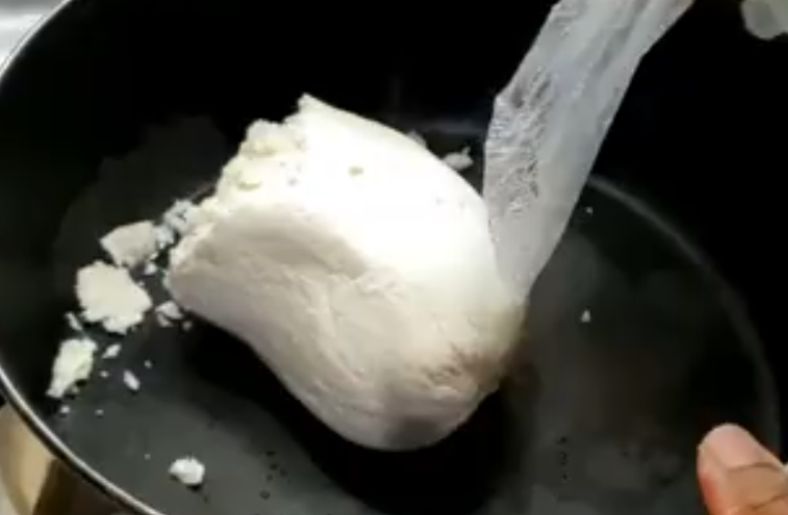
If you don’t have time to peel and grate cassava yourself, frozen grated cassava makes things easier.
It’s ready to go when you are, and it still delivers the flavor you expect.
What Frozen Grated Cassava Offers
Frozen grated cassava is simply raw cassava that has been peeled, shredded, blanched, and frozen to lock in freshness.
You don’t need to process anything yourself. It saves you from scraping your knuckles on a grater or spending too much time on prep.
You’ll find it in neatly packed bags at the store, already portioned and ready to use straight from the freezer.
Why It’s a Practical Swap for Fresh
Fresh cassava is great, but it takes time. You have to peel off the thick skin, cut the tuber, and grate it yourself. If you’re cooking on a tight schedule, that’s a lot.
With frozen grated cassava, all that work is done. Just open the bag, thaw what you need, and get cooking.
It works well for both weekday meals and larger cooking projects.
Storage and Shelf Life You Can Count On
Freshly ground cassava spoils quickly if left out. Frozen grated cassava gives you more time and flexibility.
It can stay in your freezer for months without losing flavor or texture. That means you can stock up without worrying about waste.
When stored properly in a sealed freezer bag, it stays ready for your next batch of pie, pudding, or fritters.
How It Fits into Your Cooking Routine
You can use frozen cassava in almost any recipe that calls for the fresh version.
It thaws quickly and keeps its moisture, making it perfect for pies, pancakes, and dumplings.
Just make sure to drain any excess water after thawing. From traditional recipes to everyday meals, it slides right in without changing how you cook or flavor your food.
Where to Buy Frozen Grated Cassava
If you want to cook with this form of cassava but skip the prep, buying it frozen is your best bet.
You just need to know where to look and what to check for.
Ethnic Grocery Stores: Your First Stop
Visit African, Caribbean, or Latin American grocery stores near you. They often carry frozen ground cassava and authentic brands.
Ask the staff if you don’t see it; it’s sometimes stocked with specialty items.
Online Retailers: Amazon, Walmart, and More
If local options are limited, try online stores like Amazon or Walmart. You’ll find various brands, user reviews, and frozen shipping options. It’s an easy way to access more choices from home.
Packaging Tips: What to Look For
Inspect packaging for damage or ice crystals. A sealed, clean bag means proper storage.
Check the freshness date, and choose products with no preservatives for a better and cleaner taste.
How Can I Freeze Grated Cassava?
Yes, you can freeze grated cassava, and it’s one of the easiest ways to keep it fresh for later use.
Just follow a few simple steps to store it correctly.
Use the Right Storage Bags or Containers
Pick airtight freezer bags or vacuum-sealed pouches to protect cassava from freezer burn.
If using containers, make sure they’re freezer-safe and leave space for expansion. Portioning saves time later.
Label Everything Before You Freeze
Write the date and contents on each container. While this form of cassava can last eight months, aim to use it within four.
Clear labeling helps you avoid waste and keeps flavors consistent.
Thaw It the Right Way Before Cooking
Thaw the cassava overnight in the fridge or use your microwave’s defrost setting.
Press out extra moisture after thawing to avoid soggy dishes and keep the texture firm when cooked.
How to Use Frozen Grated Cassava in Cooking
Frozen grated cassava makes cooking easier without losing the taste or texture you expect.
With the right prep, you can use it in recipes just like you would fresh cassava.
Thaw It Properly for Best Results
Move the cassava to the fridge and let it thaw overnight. For quicker thawing, use cold water. Skip the microwave to avoid uneven texture and soggy results.
Dry Out Extra Moisture After Thawing
After thawing, press the cassava gently with a kitchen towel to remove excess water.
This step keeps your dishes from becoming soggy and helps grated cassava hold its shape when cooked.
Use It in Both Sweet and Savory Recipes
Frozen shredded cassava works in cakes, dumplings, stews, and more. It brings texture and depth to both sweet and savory dishes.
Adjust spices if you’re replacing fresh cassava in a recipe.
Try It as a Gluten-Free Base Ingredient
Use frozen grated cassava as a gluten-free base for fritters, pancakes, or veggie patties.
Blend with other flours for structure. It gives you moisture without sacrificing texture or flavor.
Storage Tips for Grated Cassava
If you want your grated cassava to stay fresh and safe to use, how you store it matters.
Whether short-term or long-term, proper handling makes all the difference in quality.
Refrigerate It for Short-Term Use
Store shredded cassava in an airtight container in the coldest part of your fridge. It stays fresh for up to three days. Discard if it smells sour or turns slimy.
Freeze It for Long-Term Storage
Spread shredded cassava on a tray, freeze until firm, then transfer to freezer-safe bags.
Remove air, label with date, and freeze for up to six months for easy, ready-to-use portions.
Watch for Signs of Spoilage
Always check thawed or refrigerated cassava before use. Sour smell, discoloration, or sliminess means it’s spoiled.
When in doubt, throw it out to avoid ruining your recipe or risking illness.
Handle Leftovers the Smart Way
Cool cooked cassava completely before storing. Use an airtight container and refrigerate for two days or freeze for a few weeks.
Label leftovers to keep track and avoid unnecessary waste.
Frequently Asked Questions
Can I grate cassava without a food processor?
Yes. You can use a hand grater or a box grater. Just make sure the cassava is peeled, firm, and cut into manageable chunks before grating.
How do I know if my cassava is safe to eat?
Use sweet cassava for safety. If using bitter cassava, always soak or cook it properly to reduce toxins before using it in any recipe.
Is frozen grated cassava already cooked?
No. It is raw but blanched to preserve freshness. You still need to cook it before eating to ensure flavor and safety.
Can I mix grated cassava with other flours?
Absolutely. Mix it with rice, almond, or coconut flour for structure. It adds moisture and helps bind gluten-free recipes like pancakes or patties.
Conclusion
Grated cassava gives you more than just a root; it adds chew, body, and taste to recipes across cultures.
You can buy it frozen for convenience or make it fresh for control.
Either way, it fits into sweet and savory meals without needing extra ingredients or steps.
You’ve seen how to prepare it, store it, use it creatively, and even where to find it.
With the right handling, grated cassava keeps your meals satisfying and simple.
Whether you’re baking, frying, or just trying something new, this ingredient deserves a spot in your kitchen.
Save this guide and come back when cassava’s on your menu.

Chimeremeze Emeh is a writer and researcher passionate about Africa’s most transformative root crop—cassava. Through his work at cassavavaluechain.com, he explores the entire cassava industry, from cultivation and processing to its diverse applications in food, health, and industrial use.
He also writes for palmoilpalm.com, where he shares his extensive experience and deep-rooted knowledge of palm oil, covering red palm oil, palm kernel oil, and refined products. His work there reflects his lifelong connection to agriculture and his commitment to promoting sustainable value chains in Africa.
Driven by curiosity and purpose, Chimeremeze aims to shed light on how cassava continues to empower communities, strengthen food systems, and link traditional farming wisdom with modern innovation.

